- Best 3D Printers (Industrial, Desktop, & More) [2024 Guide] - July 20, 2024
- Best Filament 3D Printers [2024] - June 25, 2024
- 9 Best FDM 3D Printers (Plus FDM 3D Printing Guide) [2024] - June 24, 2024
3D printed tooling is a breakthrough technological solution disrupting traditional manufacturing processes. It harnesses the power of 3D printing and additive technology to provide a faster and more sustainable manufacturing option for tool creation in various industries such as healthcare, automobile, and transportation.
From creating molds used for manufacturing jigs and fixtures to those used in manufacturing custom-fitted prosthetics through processes like injection molding, 3D printed tooling is revolutionizing the way we design, prototype, and produce parts using tools.
In this article, we’ll delve into the applications, real-world examples, and the impressive benefits that 3D printed tooling brings to industries across the board in 2023.
What is 3D Printed Tooling?
3D printed tooling refers to using 3D printing technology to produce tools, fixtures, templates, dies, molds, jigs, and other equipment used in manufacturing processes. It is a process that involves building these tools through the layer-by-layer deposition of materials of choice in a predetermined position determined by a 3D model of the object being created.
Conventional manufacturing processes involving designing, prototyping, fabricating, and iteration of tools have been used over the years. However, these processes are unsustainable, time-consuming, and inefficient, often even representing the most expensive portion of a product development cycle, depending on the complexity of the tools produced.
3D printed tooling, as an alternative to traditional processes, shortens the tooling process by offering a faster and more efficient process of precisely and accurately creating intricate tools without the burden of lengthy conventional tooling methods.
3D Printed Tooling Example
3D printed tooling has been adopted in many production processes by companies in several industries. However, one commendable example of 3D printed tooling usage is by Wilson Sporting Goods, a company that creates equipment for many sports, including baseball, American football, fastpitch, and soccer.
Wilson R&D needed a more effective process to respond to ever-increasing supply chain challenges for a youth baseball bat handle. Since traditional production could drag production up to several weeks and the existing in-house tooling options were too expensive, the combination of the Nexa3D’s Freeform Injection Molding (FIM) and the ultrafast and powerful LSPc technology was the solution Wilson R&D needed.
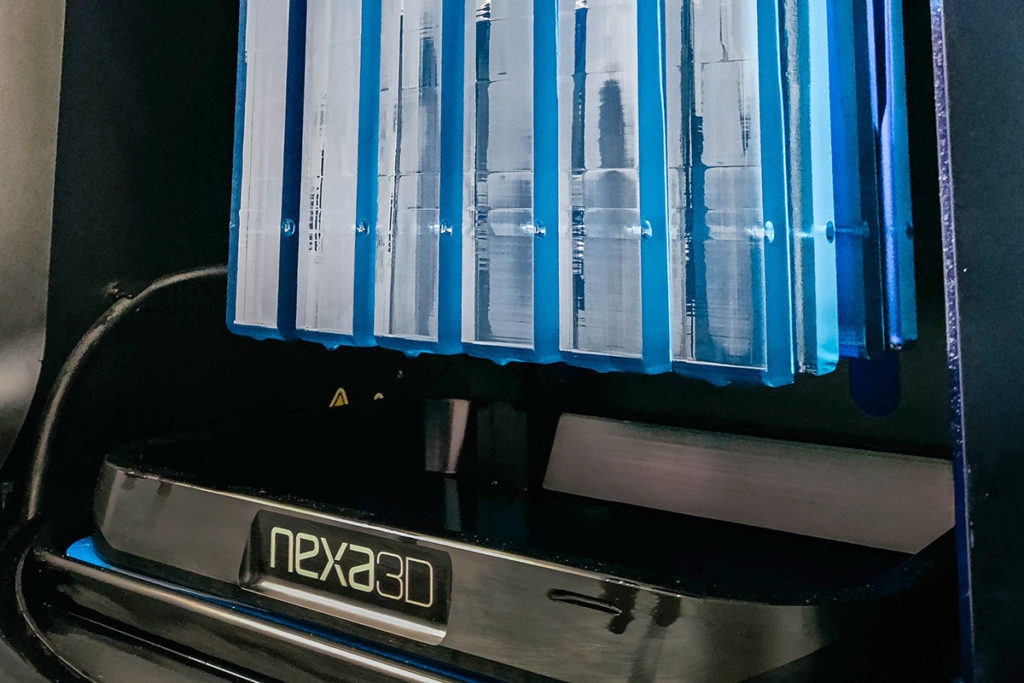
Nexa3D x Wilson
With the Nexa3D NXE 400, Wilson R&D was able to print 12 mold halves (6 mold sets) in 9 hours, with each mold set being able to yield 4 to 6 final-use bats. Using this solution, the Wilson R&D group can now produce multiple parts of any product at once rapidly, allowing quick reiterations in a single production run.
Another example is Alpine. This company is considered one of the leading experts in designing and manufacturing custom-engineered parts for industries such as aerospace, energy, space, and more. One of the major problems Alpine faced was that the conventional injection molding approach required significant upfront investment in permanent steel tooling, restricting the ability to produce prototype parts rapidly.
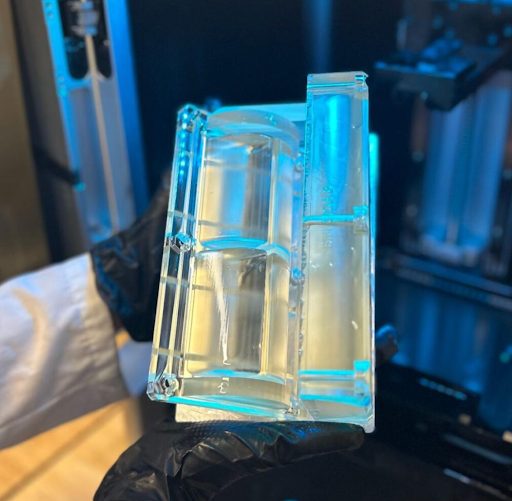
Alpine x Nexa3D
To combat this, Alpine integrated Nexa3D’s XiP 3D printer along with Nexa3D’s xMOLD resin into their operations. Freeform Injection Molding with xMOLD allowed them to overcome the challenges associated with traditional metal tooling. They reduced production costs by as much as 86% and lead time by 91%.
Let’s also take a look at Fraunhofer IFAM. Fraunhofer is a leader in Metal Injection Molding (MIM) and is used by companies in various industries such as aerospace, maritime, and energy. Fraunhofer recently decided to implement the Freeform Injection Molding process powered by Nexa3D’s XiP Desktop 3D printer and LSPc® technology to support research into new applications while lowering lead times and costs.
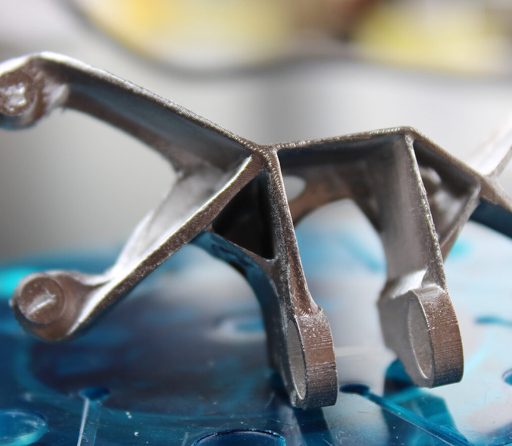
Nexa3D x Fraunhofer
This has given them increased design freedom and the ability to offer prototype metal parts in 10 days or less.
3D Printed Tooling Benefits
3D printed tooling is a breakthrough for manufacturers, offering numerous benefits that improve production processes by accelerating product development. Some notable benefits of 3D printed tooling include:
Accelerated Production
Traditional tooling processes involve a wide range of steps from designing to fabrication that cause long lead times in tool creation. Instead of dealing with these long manufacturing times and constantly making replacement machine-tooled parts, manufacturers can use 3D printed tooling solutions as a faster and more affordable way to produce new tools to scale.
3D printing allows for rapid tool fabrication, significantly shortening production cycle time. This results in faster time to market, enabling manufacturers to meet the demands of daily-use products. These faster production launches also mean earlier revenue generation and a potential for increased profitability as manufacturers can now capitalize on market opportunities more swiftly.
More importantly, the ability to build tools fine-tuned to exact specifications reduces the need for redesigning tools. This significantly reduces costs over time.
Quick Iterations
Quick iteration is a process that allows for the rapid design, testing, and refining of a product in a short timeframe, aiming to improve based on feedback. This method speeds up development and ensures products adapt to changing needs for optimal results. 3D printing elevates this approach by offering unmatched design flexibility.
With 3D printing, both small and large enterprises can explore intricate and custom tool designs. This technique not only provides a vast range of material choices, from metals to plastics, but it’s also cost-effective.
As a result, companies can experiment with various designs, refining their tools for peak performance and efficiency, bridging the gap between the initial idea and the final product seamlessly.
Improved Products
With 3D printing, manufacturers can put tool designs through rigorous testing and validation processes. This makes it easier to identify weak spots in designs and rectify these design flaws in the earlier stages of the production cycles.
The ability to identify and correct design flaws not only prevents the problem of setbacks due to unnoticed tool design weaknesses but also helps produce higher-quality end products.
Additionally, the ability to quickly adapt tooling to specific projects and customers through design customization enables manufacturers to create products that cater to a broader range of customer needs.
Reduced CAPEX
3D printed tooling reduces the financial barriers associated with traditional tooling methods, especially when it comes to capital expenditure (CAPEX). CAPEX refers to the funds used by a company to acquire, upgrade, and maintain physical assets. This can include property, plants, buildings, technology, or equipment
Many production processes, like CNC machining and injection molding, require unique tools, and a defect in a tool can set back an entire production line. As such, many manufacturers that use traditional tooling methods go through painstaking processes to ensure tool designs are flawless. However, this means they require not only enough time to design, fabricate, and customize tools from scratch but also enough finances as capital to invest in molds and machining equipment.
3D printed tooling eliminates the need for expensive molds, thereby reducing the initial CAPEX and eliminating expensive production runs. Additionally, 3D printing generates less material waste compared to subtractive traditional tooling methods, thereby contributing to cost savings.
3D Printed Tooling Applications
3D printed tooling is applied in various manufacturing stages in production. These include:
Freeform Injection Molding
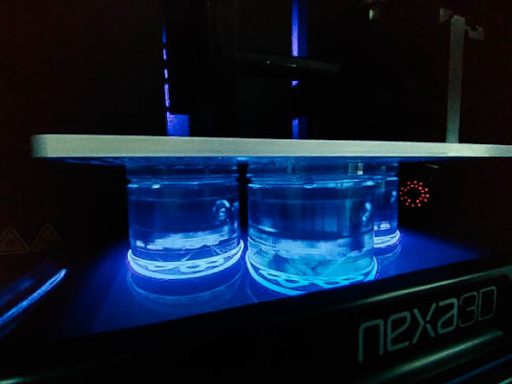
What it is:
Freeform injection molding is a hybrid manufacturing process developed by Nexa3D. It combines 3D printing with injection molding to allow the creation of complex structures and parts that will otherwise be unachievable using conventional printing processes.
How it works:
Nexa3D uses their ultrafast industrial XiP Pro 3D printers to perform injection molding tooling while harnessing the size and speed of the XiP Pro.
- The process begins with a CAD file that contains the design, material specifications, measurements, and other necessary data about the structure to be printed.
- The design is converted to a mold
- The mold is evaluated and reviewed to spot and adjust changes if necessary
- The mold is 3D printed and post-processed if necessary
- Other stages of injection molding include the set-up of the injection mold machine, injecting molten plastic resin into the 3D-printed mold cavity under high pressure, and then cooling
- The cool plastic is removed from the mold or placed in a demolding station to dissolve the mold.
- Molded parts are inspected for quality control.
Use Cases:
- Efficient, cost-effective, and rapid production of molds for design verification, prototyping, and end-use parts e.g. Wilson R&D’s baseball bats
- Automotive prototyping for complex parts, such as interior components
- Medical device components such as hearing aids
Explore how Nexa3D can revolutionize your injection molding processes using a combination of the groundbreaking XiP and XiP Pro and patented xMOLD resin in freeform injection molding.
Additional Molding Processes
What it is:
There are other molding processes that fall outside the realm of the most common methods, such as injection molding. Methods include compression molding, blow molding, rotomolding, and more. Each has its unique advantages tailored for specific applications and material types.
How it works:
Manufacturers can choose any 3D printing technique that accommodates the specific requirements of the tools they are trying to make.
- Create a CAD design of your tool
- Choose a 3D printing technique that aligns with your needs and material choices
- Upload the CAD design to the 3D printer chosen and print a 3D structure of the mold
- Post-process the mold, review it, and make adjustments if necessary.
Use Cases:
- Blow molding for producing plastic containers, e.g., PepsiCo’s use of Nexa3D’s NXE 400 and xPEEK147 material for the production of their custom plastic bottles
- Manufacturing automotive components with hollow interior parts
- Production of molds for electrical components like insulators.
Jigs & Fixtures
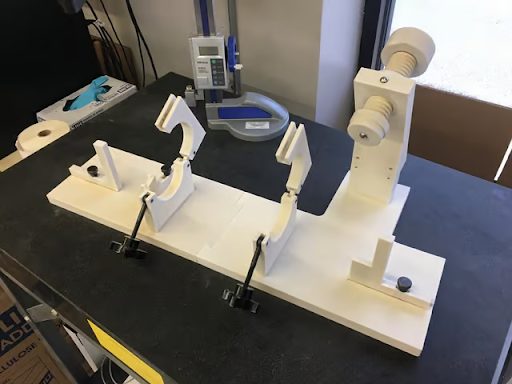
What it is:
Jigs & fixtures are devices used in production to hold and guide tools and workpieces during manufacturing and assembly processes. Although the terms are used interchangeably, jigs refer to tools that hold a cutting tool in place or guide it in cutting tasks, while fixtures hold a workplace steady in a fixed position or orientation.
One instance of 3D-printed jigs and fixtures is the case of Applied Rapid Technologies (ART), which used the NXE 400Pro to print over 35 pieces of mold parts, jigs, and fixtures in one or two hours.
How it works:
Using 3D printing for jigs & fixtures follows a similar tooling process to above, including:
- Creating a CAD file of the jigs or fixtures design
- Uploading the CAD file to the 3D printer
- Printing the 3D structure of the jigs and fixtures designed
This allows businesses to reduce the expenses associated with traditional machining by enabling quick design iterations. Its ability to create complex geometries and highly customized designs makes it ideal for producing specialized jigs and fixtures tailored to specific manufacturing needs.
Use Cases:
- Creating jigs & fixtures that aid precise assembly of automotive and industrial components
- Custom jigs and fixtures created for medical applications, such as jigs and fixtures for medical device assembly
Custom Production Parts
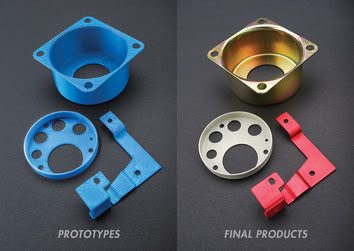
What it is:
Custom production parts refer to components that are specifically designed and manufactured to meet unique specifications, requirements, or functions. Unlike standard or off-the-shelf parts, custom parts are often tailored for specific applications or products, ensuring that they fit precisely into a design or fulfill a particular need.
3D printing can be used for a wide range of custom products, such as molds, casting patterns, and end products. 3D printing can produce end-products that require intricate geometries and high-quality surface finishes, especially with mSLA 3D printers.
Manufacturers use mSLA 3D printers to mask the necessary pixels while printing, allowing only the necessary pixels to pass light. The result is a distortion-free product with better surface finishes.
How it works:
Similar to other 3D printed tooling processes, you create custom products by:
- Design the 3D model of the tool for custom production using CAD software
- Upload the CAD file created to the 3D printer
- Print the tool
- Use the tool for your production
By producing custom parts with 3D printing, manufacturers can swiftly adapt to individual specifications. This method is more cost-efficient for low-volume productions, eliminating the need for large inventories and reducing overheads tied to traditional manufacturing.
Also, 3D printing ensures prompt delivery of custom components, meeting customer demands faster.
Use Cases:
- Medical Field: Custom implants or prosthetics tailored to a patient’s anatomy
- Aerospace: Lightweight components with intricate internal geometries to optimize performance without compromising strength
- Automotive: Custom car parts for specialized or luxury vehicles, or for prototyping new components
- Research & Development: Prototyping innovations or testing novel designs before larger-scale production
Optimize Your 3D Printed Tooling
3D printed tooling offers manufacturers an opportunity to transform manufacturing processes through the rapid, cost-effective, and efficient production of tools. With the power to expedite production, foster innovation through quick iterations, and ultimately improve product quality, 3D printed tooling stands at the forefront of modern manufacturing.
By leveraging the advantages of 3D printing technologies, such as the freeform injection molding solution provided by Nexa3D, manufacturers can stay ahead in the ever-evolving manufacturing landscape.
